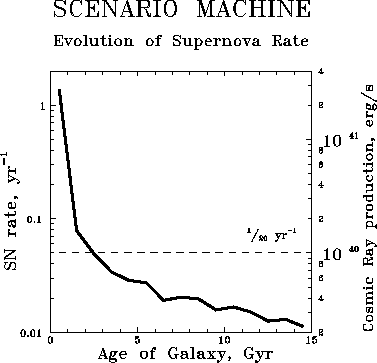Next: Radiopulsars as Sources of Up: Cosmic Rays and Evolution Previous: Cosmic Rays and Evolution
![]()
![]()
![]()
![]()
![]()
Next: Radiopulsars
as Sources of Up: Cosmic
Rays and Evolution Previous: Cosmic
Rays and Evolution
Presently, there is little doubt that galactic CR can be generated at rapidly expanding shock fronts produced by supernova explosions. In fact, it would be more accurate not to use the term supernova explosions, since not every collapse of a normal star into a relativistic configuration leads to the observed supernova phenomenon, but to refer to matter ejection during the course of compact star formation. Statistical properties of radiopulsars in our Galaxy indicate a formation rate of NS of about 1 per 10-20 years in the present cosmological epoch, while direct astronomical observations have so far not detected supernova explosions at this high rate.
On average, each ejected stellar envelope removes kinetic energy of
the order of ![]() erg s
erg s![]() , so that for an event rate of 1 per 10 years, kinetic energy transformation
efficiency into relativistic particles of a few percent in the envelope
would be sufficient to maintain the observed energy density of CR. However,
as noted by de Freitas Pacheko and Barbue (1993)[40],
the energy density of CR is determined not only by the efficiency and power
of an individual source at the present time, but also by the total power
radiated by the source which can be time-dependent in a real situation
and thus defined by different evolutionary factors.
, so that for an event rate of 1 per 10 years, kinetic energy transformation
efficiency into relativistic particles of a few percent in the envelope
would be sufficient to maintain the observed energy density of CR. However,
as noted by de Freitas Pacheko and Barbue (1993)[40],
the energy density of CR is determined not only by the efficiency and power
of an individual source at the present time, but also by the total power
radiated by the source which can be time-dependent in a real situation
and thus defined by different evolutionary factors.
For example, it is quite natural to expect the supernova rate at earlier epochs to be significantly enhanced in comparison with the present due to intensive formation of stars of the ``first generation''. This effect was in fact predicted by results of numerical modeling of galactic evolution with the help of the Scenario Machine (Lipunov and Postnov, 1988[116]), which revealed a dramatic evolution (by two orders of magnitude) of the supernova explosion rate during the first 5-7 billion years of the galactic life. A possible way to check this strong effect could be direct observations of cosmological supernovae using the Hubble Space Telescope. This, however, has not be done so far for reasons that are well known.

Figure 36: Evolution of SN rates for elliptical
and spiral galaxies.
However, another, indirect but quite real way of doing this exists, which can be called ``Galactic Archeology'' and is connected with CR studies (de Freitas Pacheko and Barbue, 1993[40]).
It is well known that rare light nuclei such as 2D, ![]() He,
6Li, 7Li, 7Be,
He,
6Li, 7Li, 7Be, ![]() Be,
10B, 11B cannot result from nuclear reactions inside stars. Instead, they
are rapidly burnt in stellar interiors. Nevertheless, astronomical observations
show these nuclei to exist in stellar atmospheres, implying their origin
either in cold matter bombarded by relativistic particles, or as a result
of cosmological nuclear reactions. Unlike deuterium and the
Be,
10B, 11B cannot result from nuclear reactions inside stars. Instead, they
are rapidly burnt in stellar interiors. Nevertheless, astronomical observations
show these nuclei to exist in stellar atmospheres, implying their origin
either in cold matter bombarded by relativistic particles, or as a result
of cosmological nuclear reactions. Unlike deuterium and the ![]() He
isotope, which are not produced by spallation reactions and are thought
to be of cosmological origin (Alpher et al., 1948[5]),
nuclei of beryllium (in particular, the isotope
He
isotope, which are not produced by spallation reactions and are thought
to be of cosmological origin (Alpher et al., 1948[5]),
nuclei of beryllium (in particular, the isotope ![]() Be)
seem to be produced during the interaction of matter with CR (Bradt and
Peters, 1950[25]; see, however,
Fowler et al., 1955[51],
who suggested these nuclei to be formed in stellar atmospheres during interactions
of protons accelerated in solar-like flares). Spallation reactions occur
during collision of protons and alpha-particles with so called M-elements
of average mass (CNO nuclei).
Be)
seem to be produced during the interaction of matter with CR (Bradt and
Peters, 1950[25]; see, however,
Fowler et al., 1955[51],
who suggested these nuclei to be formed in stellar atmospheres during interactions
of protons accelerated in solar-like flares). Spallation reactions occur
during collision of protons and alpha-particles with so called M-elements
of average mass (CNO nuclei).
As for ![]() Be, it is definitely of non-cosmological origin, because first, the standard
Big Bang Nucleosynthesis model produces mush less content of beryllium
in comparison with hydrogen (
Be, it is definitely of non-cosmological origin, because first, the standard
Big Bang Nucleosynthesis model produces mush less content of beryllium
in comparison with hydrogen ( ![]()
![]() Be/H)
= -15.56), and, secondly, the primordial origin of the
Be/H)
= -15.56), and, secondly, the primordial origin of the ![]() Be
contradicts the observed dependence of the beryllium isotope on metallicity
[Fe/H].
Be
contradicts the observed dependence of the beryllium isotope on metallicity
[Fe/H].
Therefore, comparison of the ![]() Be
content in young and old stars can be an indicator of the evolution of
activity of CR sources in the Galaxy.
Be
content in young and old stars can be an indicator of the evolution of
activity of CR sources in the Galaxy.
Figure 36 shows the SN rate evolution for elliptical and spiral galaxies taken from the Scenario Machine calculations.